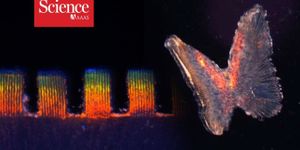A Newly Discovered Evolutionary Pathway in Viruses
Scientists have learned more about how viruses can change to fit into their environment; they use a previously unknown pathway in evolution. An international team of researchers showed that when a bacterial virus infects its host, it also gains the ability to infect other things. The investigators say that this work, which has been reported in Science, answers some longstanding questions about how genes gain new functions, and how mutations make it easier for viruses to jump from infecting one species to another.
"This research shows us that viruses are much more adaptable than previously anticipated," said the senior author of the new study, Justin Meyer, an assistant professor with UC San Diego Biological Sciences. "By learning how viruses achieve evolutionary flexibility, we have new insight into how to set up roadblocks to stop the emergence of new diseases."
Viruses bind to receptors on the surface of cells, with a specific fit like locks have their own keys. The key on the virus, the host-recognition protein, attaches to the receptor lock, and then the virus can enter the cell. Investigators have been working to learn more about how genetic mutations modify the protein keys and allow them to get into the locked cells of new hosts. It’s been known that it only takes a few mutations to make that happen, but how the mutations occur has remained a mystery.
For this work, the scientists used a virus, lambda, that infects bacterial cells and is often used in experiments. They determined that lambda is able to manipulate the process by which genes are translated into proteins. A single gene can be made to yield several proteins, the researchers found. The lambda virus carries a protein sequence that has inherent structural instability that results in the synthesis of two host-recognition proteins, which are different. Those different proteins work to open different receptor locks.
"We were able to capture this evolutionary process in action," noted lead author Katherine Petrie, who led the lambda experiments. "We found that the protein's 'mistakes' allowed the virus to infect its normal host, as well as different host cells. This nongenetic variation in the protein is a way to access more functions from a single DNA gene sequence. It's like a buy-one-get-one-free special for the protein."
This work continues, as the researchers search for additional examples of this newly identified evolutionary phenomenon, and to describe it in molecular detail. They also want to know how frequently it happens.
"This is a very atypical adaptation in that it's an evolutionary innovation," added Meyer.
Learn more about viruses and how they evolve from the video.
Sources: AAAS/Eurekalert! Via UCSD, Science









